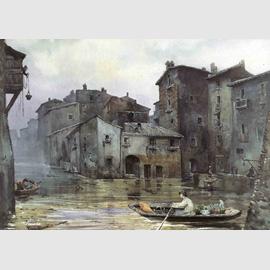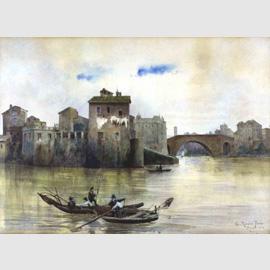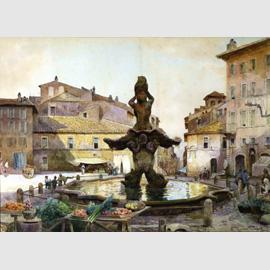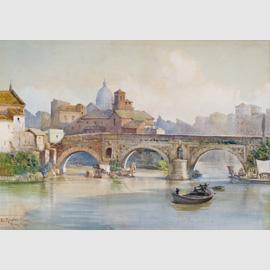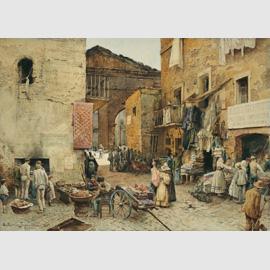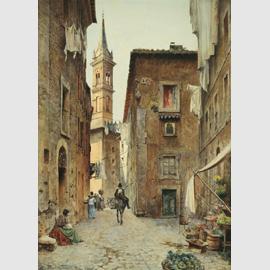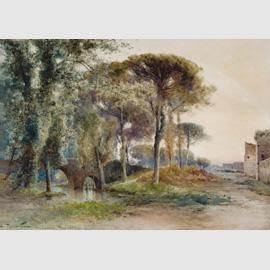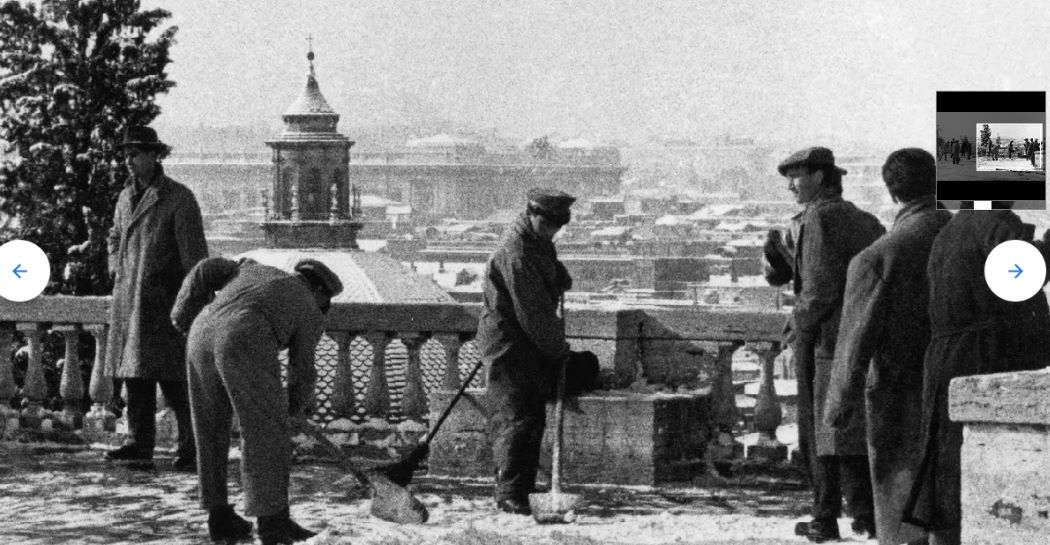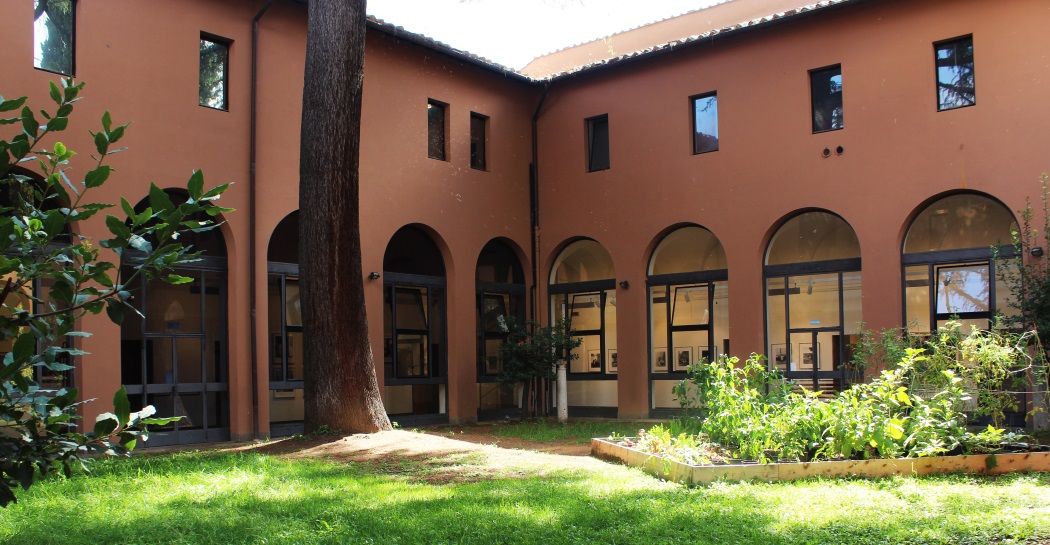Landscapes recalled: watercolours of Rome between 1876 and 1895 by Ettore Roesler Franz
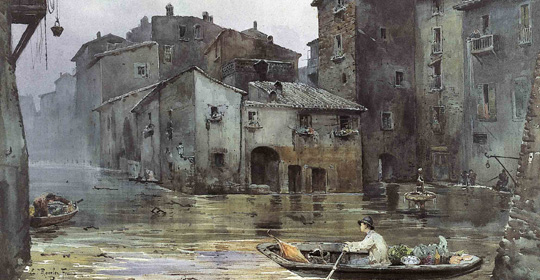
The districts, narrow streets and houses of times past shown in the watercolours painted by Ettore Roesler Franz (1845-1907) provide a record and a reminder of how Rome looked up until the end of the 19th century.
Today, to mark the passing of the one hundred year’s since he died, the city pays homage to the artist with this magnificent exhibition entitled “Landscapes recalled: watercolours of Rome between 1876 and 1895 by Ettore Roesler Franz” that opened in the Museum of Rome in Trastevere on 19 December 2007 and will run until 24 March 2008.
The exhibition is the fruit of a joint effort by the City of Rome’s Office for Cultural Policies and the Department for Cultural Promotion and Co-operation at the Ministry for Foreign Affairs who renewed and formalized their long-standing collaboration and commitment to promoting cultural events by the signing of a Document of Intent on April 3, 2007 at the City Offices known as the Campidoglio.
The Museum of Rome in Trastevere is a long standing symbol of the life of ordinary Romans and a selection of Roesler Franz watercolours painted between the end of the 18th and during the 19th century have always been part of it’s permanent collection so it is a fitting first host to an exhibition that will then take to the road, stopping off in various Italian Cultural Institutes in both Eastern and Northern Europe.
A true master of the difficult techniques used in watercolours and a polyglot artist with a cosmopolitan mentality who was never-the-less strongly attached to his native city, Ettore Roesler Franz used his art to bear witness to the tremendous changes that took place in Rome once it had been proclaimed capital of Italy in 1870 and following the city’s last, disastrous flood at the end of that same year. The rapidity of the modernization process that the swept the city forwards was the trigger for the artist to paint and photograph the parts of the city being redeveloped and those most at risk of being demolished and disappearing forever, in particular, along the banks of the River Tiber – where existing buildings were destroyed in order to make way for the high retaining walls of the embankment built as a defence against future floods – as well as Piazza Venezia, the Ghetto and the historic districts of Borgo, Trastevere and Monti all of which lost important architectural, artistic and other urban features that represented Rome’s past.
79 of the 120 watercolours produced by the artist between 1876 and 1895 can be admired in the “Recollections of the Past” exhibition that encompasses both the left and right banks of the Tiber in order to tell the story of how life really was in the different districts depicted.
A few self portraits and paintings of the artist’s family are also on show, as are 15 paintings featuring the aqueducts that run through the Roman countryside. These “water giants” are grandiose bridges often featured by Roman artists and their paintings were almost an open invitation to the observer to seek out these evocative and little known landmarks of the rural surroundings. Every single painting is an anthropologically sensitive representation of the many aspects of daily life in a city that still enjoyed the social and human dynamics of a village. These watercolours of a Rome that no longer exists provide a detailed account of the traditional skills, knowledge and activities, now long forgotten, connected to the economy of the river. The construction of the embankment walls along the Tiber meant that although the
problems caused by flooding were resolved, many livelihoods that depended on the river were destroyed:
Water carriers, tanners, those who made terracotta cooking pots and dishes, dyers, ferrymen, millers, fishermen, wood-carriers, bargees, washer-women, the men who quarried river sand, and Tiber boatmen generally all slowly disappeared; a world and a way of life that the 120 watercolours painted by this Roman landscape artist documented in full in three separate series, each of 40 paintings. His first Roman paintings to show the ending of an era were exhibited in the Palazzo delle Esposizioni in 1883, the year of its inauguration. Leopoldo Torlonia, Rome’s Mayor at that time, was directly responsible for purchasing the collection, which cost the city 18,000 lire. The last two series however, were bought for a total of 35,000 lire the year after Roesler Franz died - but only after several council debates on the subject. The complete collection was shown for the first time in the Castel Sant’Angelo during the Universal Exhibition of Rome in 1911.
Best known as the watercolours of “Roma sparita” – vanished Rome - the collection was first housed in the Palazzetto della Farnesina in via Baullari and only later transferred to the newly inaugurated site of the Museum of Rome in Piazza Bocca della Verità (Mouth of Truth Square) that closed in 1939 because of the war. In 1952 they were moved to the museum’s new site in the Palazzo Braschi, but in 1980, the first 28 paintings from the collection were sent to the newly opened Folklore Museum in Trastevere where they are still exhibited today, although for limited periods and on a rotation basis with the rest of the collection.
Ettore Roesler Franz, landscape artist and guardian of the city’s memory, travelled the length and breadth of Italy and Europe as previous exhibitions prove: 46 in Italy and 23 abroad. He was particularly drawn to Britain – in fact all his painting materials, the paper, paints and brushes he used came from there – and it was a country he returned to time and time again as well as the place that most buyers of his works came from. In the 35 or so years that he spent painting, this genial landscape artist who was a great admirer of Turner, Constable and above all of Corot, painted more than 1000 watercolours and not only founded a Society for Watercolorists in Rome but acted as its President many times. He only ever painted around 15 canvases in oil however and produced just a few works in tempera. Watercolours were his passion and he firmly believed that they were the best medium for capturing rural landscapes and in particular the transparent quality of sky and water.
His favourite subjects included the countryside around Rome and the rest of Lazio as well as the nearby Abruzzi region, views of Tivoli and the English landscape. He will always however be associated with and most famous for his three series of “Roma sparita” that are still as evocative as ever and allow us to imagine life in Rome as it once was - and is no more.
Information
tuesday - sunday 10.00am - 8.00pm
24th and 31th december 10.00am - 2.00pm
closed: 25th december, 1st January
the ticket office closes an hour in advance
€ 5,50 ordinary
€ 4,00 reduced
Tickets and reservations
060608 every day 9.00am - 10.30pm


























